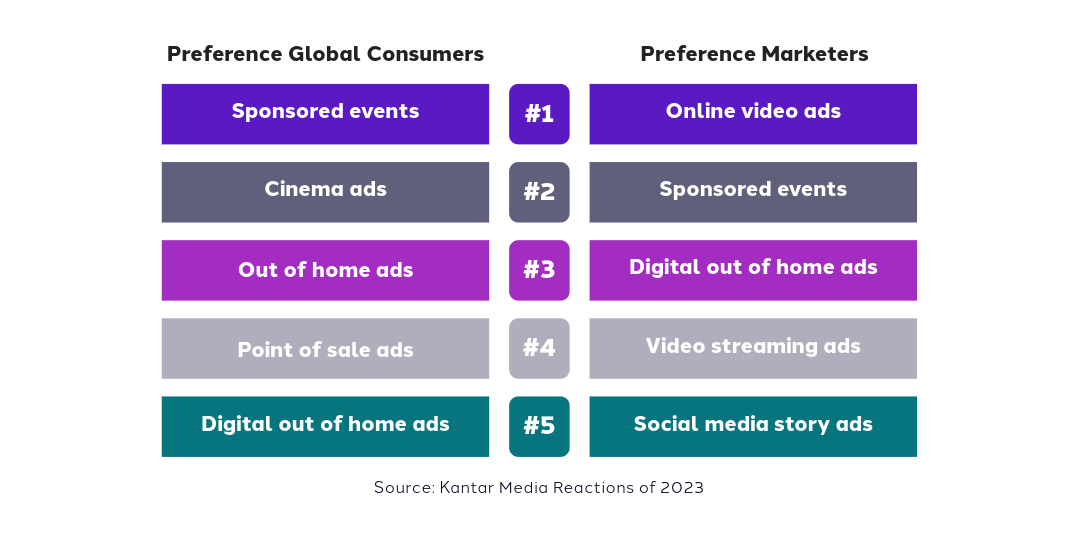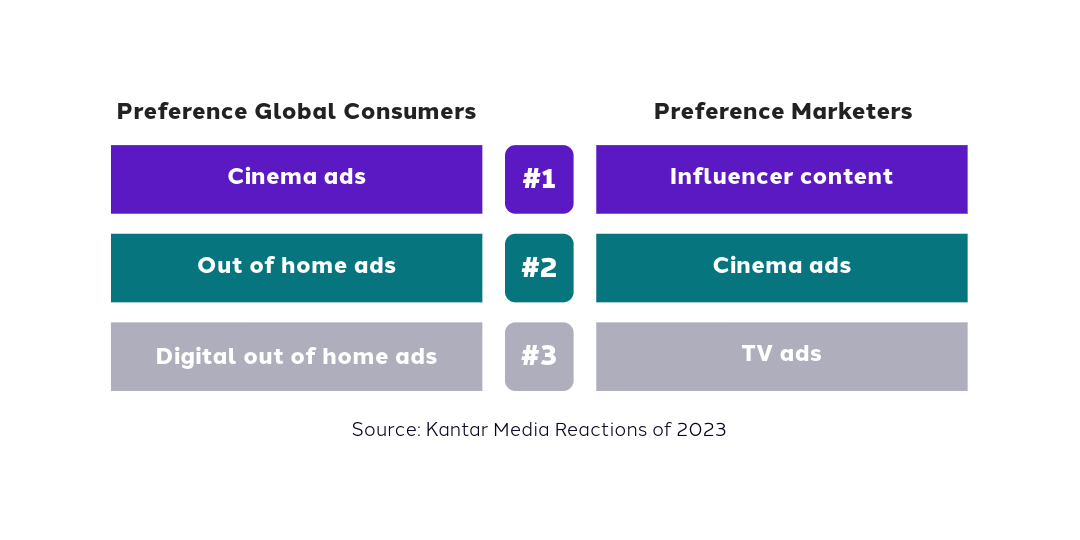This article is based on several whitepapers: Kantar’s “Media Reactions of 2023”, dentsu’s “2023 Media Trends: Change and Opportunity”, dentsu’s “Out Of Home Trend Report 2023” and Australian Outdoor Media Association (OMA)’s “The Primal Advantage”.
Linking change or disruption with the advertising branch is like linking the ocean with the tides, unsurprising. 2023 has brought forth insights into the media expectations and preferences among both consumers and marketers. One striking revelation is the affirmation that out-of-home (OOH) advertising can create a significant impact and is endorsed by consumers. However, it's essential to view this resurgence, of one of the oldest media types, within the context of shifting media preferences. We see a losing battle being fought among the top advertisers to garner the attention of youth via Regular TV. But also, a more irritated consumer, when it comes to advertisements that disrupt their usage experience, for example, online video. This is even more important if we look at the War on Attention, where media selection plays an enormous role. Within this article, we dive into all these topics and try with the gaze of the consumer.
Media experience vs marketing bias
That there’s a paradigm shift, where the consumer tells the marketeer what their preferred lines of communication are, is true. Consumers are increasingly vocal and sceptical about advertising. Below is a table from Kantar’s Media Reaction of 2023. Both consumers and marketeers were asked questions about their relationship with different media types.
Top ranking media channels

Sponsored events continue to shine as a favoured channel for both consumers and marketers. Their adaptability to the digital age, including hybrid in-person and online events, has solidified their appeal. Brands like Red Bull have made this way of branding their own, reinforcing the brand’s reputation, trust, and loyalty among consumers. Sponsored events serve as a testament to experience marketing and the enduring power of face-to-face interactions.
Consumers enjoy both life and ads more outdoors. These media types are sometimes a bit less flexible in planning but creatively they offer a broader range of options. They inherently also have a low irritability factor. Which is great for brand building and the emotional transmission of ads.
While marketeers prefer the more adaptable dynamic media types. This way marketeers can roll with the punches of society, optimise on the go and adapt creatives during campaign flights. These preferred marketeer channels usually offer more 1-to-1 communication, inherent to the digital side of the media spectrum, with the downside of stopping the consumer from gratifying their reason to use the medium and so increasing irritability.
Most consumers aren’t waiting for new ads to show up. We are task-oriented beings. We scroll through our phones to be entertained or walk through the city to get from point A to point B. If we can place ads without disrupting the consumer. We can basically guarantee long-term gains.
While it isn’t abnormal that marketeers prefer to focus on digital channels, especially for performance-centric marketeers. Reporting both lower and upper-funnel campaigns KPI’s just works better with digital channels, or it is close to impractical to measure when looking at the other media options. It’s extremely shocking to see how media expenditure and marketeer preference don’t correlate with the media expectations/needs of the consumer.
OOH stands in society
If the previous media expectation ranking is taken into account, a link is formed between both the creative facet of out of home and the high consumer preference ranking of all the different OOH branches (OOH-ads, Point-of-Sale-ads and DOOH-ads), which is unsurprising. As OOH stands within society. It reaches every layer of our communities and with some smart creative planning, it also delivers different messages. OOH offers the consumers shelter, cleans the air, facilitates charging stations for both e-cars and portable appliances, but also offers the freedom to continue their way without feeling disrupted by the advertisement.
Out-of-home advertising, both traditional and digital (DOOH), has experienced a remarkable revival, capturing the attention of consumers and marketeers (in different ways). OOH has always been the medium where creativity is rewarded. – Just look at most Cannes Lions cases. – In recent years, these creative possibilities have only increased with the digitalisation of the different OOH-networks. Digital OOH (DOOH) has addressed the "dullness" issue associated with traditional OOH, providing a canvas for creative and interactive advertising. Allowing for a more flexible and consumer-focused approach. Digital billboards have been seamlessly integrated into the urban landscape, offering interactive and captivating ad experiences.
Brands like Heineken and BMW have effectively used OOH advertising to engage consumers. Campaigns as Heineken’s 150 years celebration and the introduction of Heineken Silver or BMW’s light-in-the-box 3d activation in Antwerp have created memorable brand experiences, showcasing the potential of OOH in connecting with audiences. This is in thanks to the power of subliminal messaging, a low irritability factor and high media connectiveness with younger audiences.
Online video dominates and grows in options
While consumers gravitate toward in-person experiences, marketeers maintain their focus on online advertising. In the Dutch market, platforms like YouTube and Netflix have witnessed substantial growth in ad spending. This aligns with Kantar’s findings, where online video remains the most preferred media channel for marketeers for the fourth consecutive year. The effectiveness and data reporting of online video ads make them a compelling option for performance marketeers, especially to reach digital-savvy audiences. But we can’t forget that each time a skippable or non-skippable ad is played, the advertiser disrupts the consumer’s on-demand, with the expectation of immediate gratification, the goal of watching a specific video to fruition, which raises the irritability of the ad.
The influence of ad-based VOD and SVOD
When looking back at our own expectations for the year, dentsu aligned their views with the possible growth of the Online Video landscape with the addition of streaming services. The landscape of video-on-demand (VOD) is undergoing a transformation, with ad-based VOD (AVOD) gaining ground over subscription VOD (SVOD). Streaming giants like Disney+ and Netflix have announced/rolled out ad-supported tiers to attract new subscribers and generate additional ad revenue. This strategic shift comes as Netflix faces stagnant user numbers, while Disney continues to expand its subscriber base. The introduction of ad-supported tiers presents an opportunity to bolster subscriptions and tap into ad revenue streams. And thus, increasing the options and targetability for advertisement but also increasing the disruption to the consumers’ lives. Disney+ will add this ad tier to its roster like for example, Videoland did 3 years ago. Netflix hasn’t shared any dedicated timeline for a rollout in the Netherlands.
TV is in decline
Interestingly, the Kantar report highlights a decline in TV advertising's appeal. While TV has long been a trusted platform for marketers, its preference among consumers, especially among younger consumers, has dwindled. Our average overall watch time is declining at a rapid pace, where the average Dutch consumer used to watch about 3.2 hours a day of regular ‘channel’ TV in 2014, they now watch about 2.2 hours. Over all generations, we see decreases left and right. But the pain point for the channel is drawing in the younger generations. Especially Gen-Z is sceptical about their watch time. They enjoy the freedom that comes with streaming platforms.
Technology opens new avenues
This shift underscores the importance of innovation and adaptability in advertising. One of the newest tools in the Netherlands for TV specialists is Addressable TV, which allows brands to send out relevant and adaptable content on air depending on multiple factors. This dynamic content can activate/trigger creatives in certain geographical areas based on triggers. This dynamic possibility links with the contextualisation of creatives and day-in-a-life strategies, making an audience-based approximation of daily media consumption and focusing media buy-in during the most relevant times.
Connected TV (CTV) advertising is evolving, offering precise targeting and interactive formats. Amazon's use of virtual product placement within programming showcases the potential for seamless integration of brands. Technology enables creative and innovative advertising approaches, enhancing viewer engagement and interactivity.
Attention-based advertising
When we go even deeper in Kantar’s findings we see that there’s also a relative discrepancy between which media channels consumers link with high attention and which ones marketeers find important. This discrepancy is even more mind-boggling when dentsu and Lumens’ research is linked. OOH experiences rank again high, and disrupting/irritable ad experiences are ranked lower for the consumer. Below are two tables showcasing the divide between consumer and marketeer.
Top ranking media channels for attention

Bottom ranking media channels for attention

Attention metrics are gaining prominence in the competitive media marketplace. Understanding what captures consumers' attention is crucial for marketers. Metrics beyond impressions and viewability are becoming essential for effective advertising strategies. Attention is the most valuable commodity in today’s fast-paced world. In this world, we are constantly bombarded with information and our attention span continues to seemingly dwindle. As a result, capturing and retaining attention has become one of the most significant challenges for businesses and marketers. Technologies like eye-tracking or neuro-research offer insights into attention patterns, helping advertisers optimize their campaigns and creatives for better engagement.
The role of attention in OOH advertising
Research underscores the power of OOH advertising in capturing attention, especially in high-traffic areas like bus stops. OOH's ability to attract up to 93% of people's attention makes it a compelling choice. Visual aids, vibrant colours, motion, and DOOH formats further enhance OOH's attention-grabbing capabilities. Following research by the Australian Outdoor Media Association (OMA), when we step out of the home in the outside world, our alertness increases 2.5 times and our susceptibility to ad messaging doubles.
Navigating the multifaceted media landscape
The world is brimming with media choices, understanding changing preferences and recognizing our media bias is essential for advertisers. While OOH advertising is making a remarkable comeback, it's just one facet of a diverse landscape. The opportunity of all these emerging technologies, lie mostly in optimising day-in-a-life strategies to continue maximising media budgets and contextualize based on audiences. Marketeers should stay agile, leveraging technology, measuring attention, and exploring innovative formats to capture and retain audiences' interest. The future of advertising lies in adapting to new landscapes while creating engaging experiences across various media channels.

